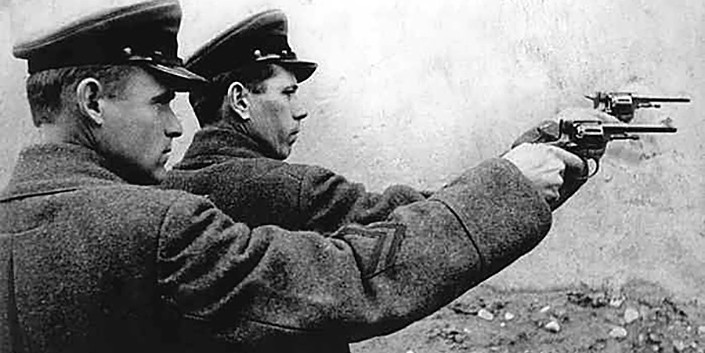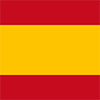Communism, the master of nazism: this is how red terror inspired the nazi dictatorship
The word "fascist" is widely used today by the extreme left to label all kinds of political rivals, whatever their ideological nature.
The use of the word "fascist" to demonize the enemies of the far-left
The far-left has historically used that word to demonize liberals, conservatives, Christian-democrats, and even social-democrats (whom they called "social-fascists" in Germany in the 1930s, as I explained here). Their purpose is to make the political rival a target to beat, because to call yourself a "fascist" is to present yourself as someone who wants to impose a dictatorship and end freedom. After all, when people hear about "fascism" they automatically think of a tyrant and mass murderer like Hitler.
The defeat of fascism in the World War II allowed to concentrate in that term all the bad connotations that can be attributed to an ideology, to the point that many people already seem to think that the first and only totalitarian threat against democracy was fascism. Furthermore, the insistence on presenting fascism as right-wing extremism helps to feed the idea that every right-wing is a potential fascist. However, history shows that neither of these two ideas are true.

The socialist origin of fascism and nazism
It must be remembered that the founder of fascism, Benito Mussolini, came from the Italian Socialist Party, from which he was expelled in 1914, the year in which he founded a newspaper entitled Il Popolo d'Italia, which maintained the definition of "socialist" in its head until 1918. That newspaper, which promulgated a nationalist socialism, became the organ of the Fascist Party in 1921.
German fascism started in 1919 with a group of significant name: the German Workers Party, which in February 1920 was renamed as the German National Socialist Workers Party (NSDAP), popularly known as the Nazi Party. Like Italian fascism, the NSDAP promoted a nationalist socialism that was opposed to both capitalism and communism, due to the internationalist character of the latter.

The common hatred of communists and fascists against democracy
The founders of fascism did not have to shake their heads too much to find the formulas with which to impose their ideas through terror. In 1917, a far-left ideologist named Lenin had already written a book, "The State and the Revolution," advocating the seizure of power through violence to establish a dictatorship. In that book, Lenin described the state as "the organized and systematic application of violence against men," even before the parties with which Hitler and Mussolini came to power in Germany and Italy appeared. Furthermore, the Russian ideologist openly despised democracy, which he described in these words: "Decide once every certain number of years which members of the ruling class are to oppress and crush the people in Parliament: here is the true essence of bourgeois parliamentarism", openly advocating its destruction.
The Red Guard: the Communist predecessor of the Hitler SS
Lenin did not write that book as a mere reverie. A few months earlier, in March 1917, the Krasnaya Gvardiya (Red Guard) was founded as an armed arm of the Bolsheviks, a militia equipped with pistols, rifles, and machine guns that at the time of the communist coup d'etat in November 1917 had about 200,000 members, becoming the germ of the Red Army. Two years were left for the appearance of Squadrismo (the Italian fascist militia), and four years for the Sturmabteilung (SA) and eight for the Schutzstaffel (SS), the militias of the Nazi Party. When the violent groups of the fascist organizations emerged, it was enough for them to copy the experience of the Red Guard, which had already become an army.

Copying Lenin's methods of conquering power through violence
The same can be said of the violent seizure of power. Shortly after writing that book, in November 1917 the Bolsheviks, led by Lenin, liquidated the newly born Russian democracy through a coup d'etat after losing the elections against the Social Revolutionaries. Again, the seizure of power by a partisan armed militia served as an example for fascism: five years later Mussolini seized power in Italy through the March on Rome in October 1922, when tens of thousands of armed fascists addressed the historic Italian capital to take power under threat of starting a civil war if they did not allow it. In November 1923 the Nazis attempted something similar in Bavaria with the failed Munich Putsch.
Cheka: the brutal Soviet political police that served as a model for the Nazi Gestapo
In 1917, with the appearance of Soviet Russia, the Bolsheviks' red flag became the flag of the new state, just as the Nazi Party in Germany would do in March 1933. Identification between a party and the state had never been reached these extremes in the history of Europe. The Soviet dictatorship quickly launched its repressive machinery. In December 1917, the fearsome Chrezvycháinaya Komíssiya (also known as Cheka), the political police of the communist dictatorship, appeared, applying purely beastly methods of torture and execution. The Czarist secret police, the dreaded Okhrana, had grown to 15,000 members. At the end of 1918 Cheka already had 40,000 officers, and two years later there were 280,000. In three years the Bolsheviks had multiplied by 18 the volume of the repressive apparatus of Tsarism.

The Cheka would later give way to the NKVD under the Stalin dictatorship. When the Nazis created the fearsome Gestapo in 1933, the Soviet secret police already had 16 years of experience in torture, persecution of dissidents, repression of strikes, deportations and executions. The Nazi regime decided to learn from the Soviet regime. In "Gestapo: Instrument of Tyranny" (1956), the British historian Edward Crankshaw wrote: "For the purposes of general supervision and repression the Gestapo modeled itself closely on the Soviet secret police. Himmler has at its command an extremely able police officer, Heinrich Mueller ... a close and devoted student of Soviet metods. Mueller was impressed by the efficiency of the internal spy system which had been perfected by the Soviet government, the effect of which, ideally, was to isolate the individual by making it impossible for anybody to trust anybody else."
Gulag: the web of communist concentration camps 14 years before of the first Nazi camp
In "Dismantling Tyranny: Transitioning Beyond Totalitarian Regimes" (2005), Ilan Berman and J. Michael Waller noted: "The Nazis likewise studied, copied, and perfected the Cheka's mass killing inventions, including the gas van into which people were herded and killed by carbon monoxide and the death camp, so they might exterminate populations more efficiently." In fact, 14 years before the creation of the first Nazi concentration camp, that of Dachau, in April 1919 Lenin ordered the creation of the Gulag, the first major web of concentration camps in history to lock up, torture and murder political prisoners. At the end of 1920 there were already 84 camps with some 50,000 political prisoners. In October 1923 there were already 315 camps with 70,000 prisoners. By 1940 there were 423, and 18 million people passed through them.

The Soviet NKVD and the Nazi Gestapo came to share information and experiences
The similarities between nazism and communism go beyond the fact that both were socialist ideologies (nationalist in one case, internationalist in the other). Nazis and soviets came to collaborate in the invasion of Poland in 1939, even making a joint parade in Brześć Litewski. But it did not end there: the Soviet NKVD and the Nazi Gestapo held joint meetings between 1939 and 1940 to share information and experience, especially in the repression of the Polish resistance. So it is not strange to see communists now acting as fascists, harassing, threatening and assaulting those who disagree. After all, communism and fascism coincide in their contempt for democracy, freedom, and human dignity: the closest thing there is to a fascist is a communist.
|
Don't miss the news and content that interest you. Receive the free daily newsletter in your email: Click here to subscribe |
- Most read
- The 'hole' without civil flights around Paris during the opening of the Olympic Games
- Spain vetoes the Russian frigate 'Shtandart', which intended to reach Vigo, in all its ports
- The interior of the Statue of Liberty torch and the sabotage that canceled its visits
- The ten oldest national flags in the world that are still in use today
- The Russian intelligence document that sparked a hoax about French troops
- The BNG boasts of the support of a terrorist group and a dictatorship at a public event
- A virtual tour of ancient Rome in full color, just as it was in its heyday

 ES
ES





Opina sobre esta entrada: